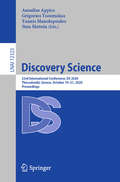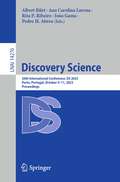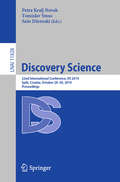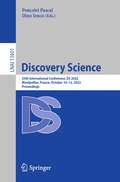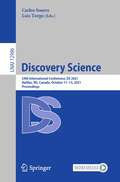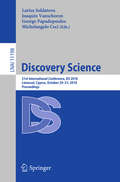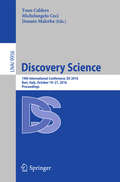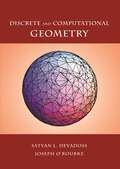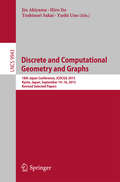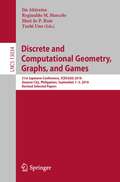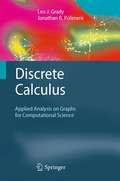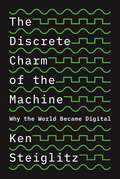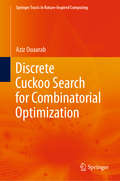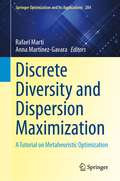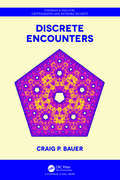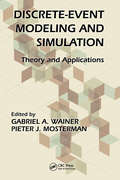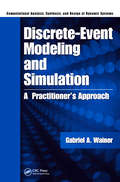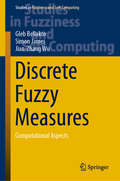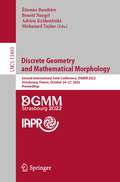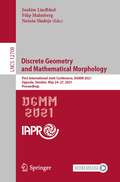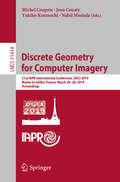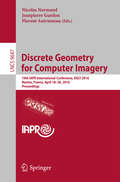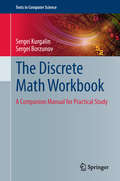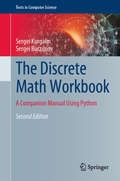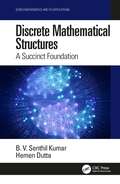- Table View
- List View
Discovery Science: 23rd International Conference, DS 2020, Thessaloniki, Greece, October 19–21, 2020, Proceedings (Lecture Notes in Computer Science #12323)
by Annalisa Appice Grigorios Tsoumakas Yannis Manolopoulos Stan MatwinThis book constitutes the proceedings of the 23rd International Conference on Discovery Science, DS 2020, which took place during October 19-21, 2020. The conference was planned to take place in Thessaloniki, Greece, but had to change to an online format due to the COVID-19 pandemic. The 26 full and 19 short papers presented in this volume were carefully reviewed and selected from 76 submissions. The contributions were organized in topical sections named: classification; clustering; data and knowledge representation; data streams; distributed processing; ensembles; explainable and interpretable machine learning; graph and network mining; multi-target models; neural networks and deep learning; and spatial, temporal and spatiotemporal data.
Discovery Science: 26th International Conference, DS 2023, Porto, Portugal, October 9–11, 2023, Proceedings (Lecture Notes in Computer Science #14276)
by Albert Bifet Ana Carolina Lorena Rita P. Ribeiro João Gama Pedro H. AbreuThis book constitutes the proceedings of the 26th International Conference on Discovery Science, DS 2023, which took place in Porto, Portugal, in October 2023. The 37 full papers and 10 short papers presented in this volume were carefully reviewed and selected from 133 submissions. They were organized in topical sections as follows: Machine learning methods and applications; natural language processing and social media analysis; interpretability and explainability in AI; data analysis and optimization; fairness, privacy and security in AI; control and spatio-temporal modeling; graph theory and network analysis; time series and forecasting; healthcare and biological data analysis; anomaly, outlier and novelty detection.
Discovery Science: 22nd International Conference, DS 2019, Split, Croatia, October 28–30, 2019, Proceedings (Lecture Notes in Computer Science #11828)
by Petra Kralj Novak Tomislav Šmuc Sašo DžeroskiThis book constitutes the proceedings of the 22nd International Conference on Discovery Science, DS 2019, held in Split, Coratia, in October 2019. The 21 full and 19 short papers presented together with 3 abstracts of invited talks in this volume were carefully reviewed and selected from 63 submissions. The scope of the conference includes the development and analysis of methods for discovering scientific knowledge, coming from machine learning, data mining, intelligent data analysis, big data analysis as well as their application in various scientific domains. The papers are organized in the following topical sections: Advanced Machine Learning; Applications; Data and Knowledge Representation; Feature Importance; Interpretable Machine Learning; Networks; Pattern Discovery; and Time Series.
Discovery Science: 25th International Conference, DS 2022, Montpellier, France, October 10–12, 2022, Proceedings (Lecture Notes in Computer Science #13601)
by Poncelet Pascal Dino IencoThis book constitutes the proceedings of the 25th International Conference on Discovery Science, DS 2022, which took place virtually during October 10-12, 2022. The 27 full papers and 12 short papers presented in this volume were carefully reviewed and selected from 59 submissions.
Discovery Science: 24th International Conference, DS 2021, Halifax, NS, Canada, October 11–13, 2021, Proceedings (Lecture Notes in Computer Science #12986)
by Carlos Soares Luis TorgoThis book constitutes the proceedings of the 24th International Conference on Discovery Science, DS 2021, which took place virtually during October 11-13, 2021.The 36 papers presented in this volume were carefully reviewed and selected from 76 submissions. The contributions were organized in topical sections named: applications; classification; data streams; graph and network mining; machine learning for COVID-19; neural networks and deep learning; preferences and recommender systems; representation learning and feature selection; responsible artificial intelligence; and spatial, temporal and spatiotemporal data.
Discovery Science: 21st International Conference, DS 2018, Limassol, Cyprus, October 29–31, 2018, Proceedings (Lecture Notes in Computer Science #11198)
by Larisa Soldatova Joaquin Vanschoren George Papadopoulos Michelangelo CeciThis book constitutes the proceedings of the 21st International Conference on Discovery Science, DS 2018, held in Limassol, Cyprus, in October 2018, co-located with the International Symposium on Methodologies for Intelligent Systems, ISMIS 2018. The 30 full papers presented together with 5 abstracts of invited talks in this volume were carefully reviewed and selected from 71 submissions. The scope of the conference includes the development and analysis of methods for discovering scientific knowledge, coming from machine learning, data mining, intelligent data analysis, big data analysis as well as their application in various scientific domains. The papers are organized in the following topical sections: Classification; meta-learning; reinforcement learning; streams and time series; subgroup and subgraph discovery; text mining; and applications.
Discovery Science: 19th International Conference, DS 2016, Bari, Italy, October 19–21, 2016, Proceedings (Lecture Notes in Computer Science #9956)
by Toon Calders, Michelangelo Ceci and Donato MalerbaThis book constitutes the proceedings of the 17th International Conference on Discovery Science, DS 2016, held in banff, AB, Canada in October 2015. The 30 full papers presented together with 5 abstracts of invited talks in this volume were carefully reviewed and selected from 60 submissions.The conference focuses on following topics: Advances in the development and analysis of methods for discovering scientific knowledge, coming from machine learning, data mining, and intelligent data analysis, as well as their application in various scientific domains.
Discrete and Computational Geometry
by Satyan L. Devadoss Joseph O'RourkeAn essential introduction to discrete and computational geometryDiscrete geometry is a relatively new development in pure mathematics, while computational geometry is an emerging area in applications-driven computer science. Their intermingling has yielded exciting advances in recent years, yet what has been lacking until now is an undergraduate textbook that bridges the gap between the two. Discrete and Computational Geometry offers a comprehensive yet accessible introduction to this cutting-edge frontier of mathematics and computer science.This book covers traditional topics such as convex hulls, triangulations, and Voronoi diagrams, as well as more recent subjects like pseudotriangulations, curve reconstruction, and locked chains. It also touches on more advanced material, including Dehn invariants, associahedra, quasigeodesics, Morse theory, and the recent resolution of the Poincaré conjecture. Connections to real-world applications are made throughout, and algorithms are presented independently of any programming language. This richly illustrated textbook also features numerous exercises and unsolved problems.The essential introduction to discrete and computational geometryCovers traditional topics as well as new and advanced materialFeatures numerous full-color illustrations, exercises, and unsolved problemsSuitable for sophomores in mathematics, computer science, engineering, or physicsRigorous but accessibleAn online solutions manual is available (for teachers only).
Discrete and Computational Geometry and Graphs: 18th Japan Conference, JCDCGG 2015, Kyoto, Japan, September 14-16, 2015, Revised Selected Papers (Lecture Notes in Computer Science #9943)
by Jin Akiyama, Hiro Ito, Toshinori Sakai and Yushi UnoThis book constitutes the thoroughly refereed post-conference proceedings of the 18th Japanese Conference on Discrete and Computational Geometry and Graphs, JDCDGG 2015, held in Kyoto, Japan, in September 2015. The total of 25 papers included in this volume was carefully reviewed and selected from 64 submissions. The papers feature advances made in the field of computational geometry and focus on emerging technologies, new methodology and applications, graph theory and dynamics. This proceedings are dedicated to Naoki Katoh on the occasion of his retirement from Kyoto University.
Discrete and Computational Geometry, Graphs, and Games: 21st Japanese Conference, JCDCGGG 2018, Quezon City, Philippines, September 1-3, 2018, Revised Selected Papers (Lecture Notes in Computer Science #13034)
by Jin Akiyama Reginaldo M. Marcelo Mari-Jo P. Ruiz Yushi UnoThis book constitutes the thoroughly refereed post-conference proceedings of the 21st Japanese Conference on Discrete and Computational Geometry and Graphs, JCDCGGG 2018, held in Quezon City, Philippines, in September 2018. The total of 14 papers included in this volume was carefully reviewed and selected from 25 submissions. The papers feature advances made in the field of computational geometry and focus on emerging technologies, new methodology and applications, graph theory and dynamics.
Discrete Calculus
by Leo J. Grady Jonathan R. PolimeniThe field of discrete calculus, also known as "discrete exterior calculus", focuses on finding a proper set of definitions and differential operators that make it possible to operate the machinery of multivariate calculus on a finite, discrete space. In contrast to traditional goals of finding an accurate discretization of conventional multivariate calculus, discrete calculus establishes a separate, equivalent calculus that operates purely in the discrete space without any reference to an underlying continuous process. This unique text brings together into a single framework current research in the three areas of discrete calculus, complex networks, and algorithmic content extraction. Although there have been a few intersections in the literature between these disciplines, they have developed largely independently of one another, yet researchers working in any one of these three areas can strongly benefit from the tools and techniques being used in the others. Many example applications from several fields of computational science are provided to demonstrate the usefulness of this framework to a broad range of problems. Readers are assumed to be familiar with the basics of vector calculus, graph theory, and linear algebra. Topics and features: presents a thorough review of discrete calculus, with a focus on key concepts required for successful application; unifies many standard image processing algorithms into a common framework for viewing a wide variety of standard algorithms in filtering, clustering, and manifold learning that may be applied to processing data associated with a graph or network; explains how discrete calculus provides a natural definition of "low-frequency" on a graph, which then yields filtering and denoising algorithms; discusses how filtering algorithms can give rise to clustering algorithms, which can be used to develop manifold learning and data discovery methods; examines ranking algorithms, as well as algorithms for analyzing the structure of a network. Graduate students and researchers interested in discrete calculus, complex networks, image processing and computer graphics will find this text/reference a clear introduction to the foundations of discrete calculus as well as a useful guide to have readily available for their work. Dr. Leo J. Grady is a Senior Research Scientist with Siemens Corporate Research in Princeton, New Jersey, USA. Dr. Jonathan R. Polimeni is a Research Fellow at the Massachusetts General Hospital in Boston, Massachusetts, USA, and Instructor in Radiology at Harvard Medical School, Boston, Massachusetts, USA.
The Discrete Charm of the Machine: Why the World Became Digital
by Kenneth SteiglitzThe genesis of the digital idea and why it transformed civilizationA few short decades ago, we were informed by the smooth signals of analog television and radio; we communicated using our analog telephones; and we even computed with analog computers. Today our world is digital, built with zeros and ones. Why did this revolution occur? The Discrete Charm of the Machine explains, in an engaging and accessible manner, the varied physical and logical reasons behind this radical transformation.The spark of individual genius shines through this story of innovation: the stored program of Jacquard’s loom; Charles Babbage’s logical branching; Alan Turing’s brilliant abstraction of the discrete machine; Harry Nyquist’s foundation for digital signal processing; Claude Shannon’s breakthrough insights into the meaning of information and bandwidth; and Richard Feynman’s prescient proposals for nanotechnology and quantum computing. Ken Steiglitz follows the progression of these ideas in the building of our digital world, from the internet and artificial intelligence to the edge of the unknown. Are questions like the famous traveling salesman problem truly beyond the reach of ordinary digital computers? Can quantum computers transcend these barriers? Does a mysterious magical power reside in the analog mechanisms of the brain? Steiglitz concludes by confronting the moral and aesthetic questions raised by the development of artificial intelligence and autonomous robots.The Discrete Charm of the Machine examines why our information technology, the lifeblood of our civilization, became digital, and challenges us to think about where its future trajectory may lead.
Discrete Cuckoo Search for Combinatorial Optimization (Springer Tracts in Nature-Inspired Computing)
by Aziz OuaarabThis book provides a literature review of techniques used to pass from continuous to combinatorial space, before discussing a detailed example with individual steps of how cuckoo search (CS) can be adapted to solve combinatorial optimization problems. It demonstrates the application of CS to three different problems and describes their source code. The content is divided into five chapters, the first of which provides a technical description, together with examples of combinatorial search spaces. The second chapter summarizes a diverse range of methods used to solve combinatorial optimization problems. In turn, the third chapter presents a description of CS, its formulation and characteristics. In the fourth chapter, the application of discrete cuckoo search (DCS) to solve three POCs (the traveling salesman problem, quadratic assignment problem and job shop scheduling problem) is explained, focusing mainly on a reinterpretation of the terminology used in CS and its source of inspiration. In closing, the fifth chapter discusses random-key cuckoo search (RKCS) using random keys to represent positions found by cuckoo search in the TSP and QAP solution space.
Discrete Diversity and Dispersion Maximization: A Tutorial on Metaheuristic Optimization (Springer Optimization and Its Applications #204)
by Rafael Martí Anna Martínez-GavaraThis book demonstrates the metaheuristic methodologies that apply to maximum diversity problems to solve them. Maximum diversity problems arise in many practical settings from facility location to social network analysis and constitute an important class of NP-hard problems in combinatorial optimization. In fact, this volume presents a “missing link” in the combinatorial optimization-related literature. In providing the basic principles and fundamental ideas of the most successful methodologies for discrete optimization, this book allows readers to create their own applications for other discrete optimization problems. Additionally, the book is designed to be useful and accessible to researchers and practitioners in management science, industrial engineering, economics, and computer science, while also extending value to non-experts in combinatorial optimization. Owed to the tutorials presented in each chapter, this book may be used in a master course, a doctoral seminar, or as supplementary to a primary text in upper undergraduate courses.The chapters are divided into three main sections. The first section describes a metaheuristic methodology in a tutorial style, offering generic descriptions that, when applied, create an implementation of the methodology for any optimization problem. The second section presents the customization of the methodology to a given diversity problem, showing how to go from theory to application in creating a heuristic. The final part of the chapters is devoted to experimentation, describing the results obtained with the heuristic when solving the diversity problem. Experiments in the book target the so-called MDPLIB set of instances as a benchmark to evaluate the performance of the methods.
Discrete Encounters (Chapman & Hall/CRC Cryptography and Network Security Series)
by Craig BauerEschewing the standard dry and static writing style of traditional textbooks, Discrete Explorations provides a refreshing approach to discrete mathematics. The author combines traditional course topics with popular culture, applications, and various historical examples. This book focuses on the historical development of the subject and provides details on the people behind mathematics and their motivations, which will deepen readers’ appreciation of mathematics. With its unique style, the book covers many of the same topics found in other texts but done in an alternative, entertaining style that better captures readers’ attention. Defining discrete mathematics, the author also covers many different topics. These include combinatorics, fractals, permutations, difference equations, graph theory, trees and financial mathematics. Not only will readers gain a greater impression of mathematics, but they’ll be encouraged to further explore the subject. Highlights: Features fascinating historical references to motivate readers Text includes numerous pop culture references throughout to provide a more engaging reading experience Its unique topic structure presents a fresh approach The text’s narrative style reads more like a popular book instead of a dry textbook Covers many topics from combinatorics, as well as discrete mathematics
Discrete-Event Modeling and Simulation: Theory and Applications (Computational Analysis, Synthesis, and Design of Dynamic Systems)
by Pieter J. Mosterman Gabriel A. WainerCollecting the work of the foremost scientists in the field, Discrete-Event Modeling and Simulation: Theory and Applications presents the state of the art in modeling discrete-event systems using the discrete-event system specification (DEVS) approach. It introduces the latest advances, recent extensions of formal techniques, and real-world examples of various applications. The book covers many topics that pertain to several layers of the modeling and simulation architecture. It discusses DEVS model development support and the interaction of DEVS with other methodologies. It describes different forms of simulation supported by DEVS, the use of real-time DEVS simulation, the relationship between DEVS and graph transformation, the influence of DEVS variants on simulation performance, and interoperability and composability with emphasis on DEVS standardization. The text also examines extensions to DEVS, new formalisms, and abstractions of DEVS models as well as the theory and analysis behind real-world system identification and control. To support the generation and search of optimal models of a system, a framework is developed based on the system entity structure and its transformation to DEVS simulation models. In addition, the book explores numerous interesting examples that illustrate the use of DEVS to build successful applications, including optical network-on-chip, construction/building design, process control, workflow systems, and environmental models. A one-stop resource on advances in DEVS theory, applications, and methodology, this volume offers a sampling of the best research in the area, a broad picture of the DEVS landscape, and trend-setting applications enabled by the DEVS approach. It provides the basis for future research discoveries and encourages the development of new applications.
Discrete-Event Modeling and Simulation: A Practitioner's Approach (Computational Analysis, Synthesis, and Design of Dynamic Systems)
by Gabriel A. WainerComplex artificial dynamic systems require advanced modeling techniques that can accommodate their asynchronous, concurrent, and highly non-linear nature. Discrete Event systems Specification (DEVS) provides a formal framework for hierarchical construction of discrete-event models in a modular manner, allowing for model re-use and reduced development time. Discrete Event Modeling and Simulation presents a practical approach focused on the creation of discrete-event applications. The book introduces the CD++ tool, an open-source framework that enables the simulation of discrete-event models. After setting up the basic theory of DEVS and Cell-DEVS, the author focuses on how to use the CD++ tool to define a variety of models in biology, physics, chemistry, and artificial systems. They also demonstrate how to map different modeling techniques, such as Finite State Machines and VHDL, to DEVS. The in-depth coverage elaborates on the creation of simulation software for DEVS models and the 3D visualization environments associated with these tools. A much-needed practical approach to creating discrete-event applications, this book offers world-class instruction on the field’s most useful modeling tools.
Discrete Fuzzy Measures: Computational Aspects (Studies in Fuzziness and Soft Computing #382)
by Gleb Beliakov Simon James Jian-Zhang WuThis book addresses computer scientists, IT specialists, mathematicians, knowledge engineers and programmers, who are engaged in research and practice of multicriteria decision making. Fuzzy measures, also known as capacities, allow one to combine degrees of preferences, support or fuzzy memberships into one representative value, taking into account interactions between the inputs. The notions of mutual reinforcement or redundancy are modeled explicitly through coefficients of fuzzy measures, and fuzzy integrals, such as the Choquet and Sugeno integrals combine the inputs. Building on previous monographs published by the authors and dealing with different aspects of aggregation, this book especially focuses on the Choquet and Sugeno integrals. It presents a number of new findings concerning computation of fuzzy measures, learning them from data and modeling interactions. The book does not require substantial mathematical background, as all the relevant notions are explained. It is intended as concise, timely and self-contained guide to the use of fuzzy measures in the field of multicriteria decision making.
Discrete Geometry and Mathematical Morphology: Second International Joint Conference, DGMM 2022, Strasbourg, France, October 24–27, 2022, Proceedings (Lecture Notes in Computer Science #13493)
by Étienne Baudrier Benoît Naegel Adrien Krähenbühl Mohamed TajineThis book constitutes the proceedings of the Second IAPR International Conference on Discrete Geometry and Mathematical Morphology, DGMM 2022, which was held during October 24-27, 2022, in Strasbourg, France.The 33 papers included in this volume were carefully reviewed and selected from 45 submissions. They were organized in topical sections as follows: discrete and combinatorial topology; discrete tomography and inverse problems; multivariate and PDE-based mathematical morphology, morphological filtering; hierarchical and Graph-Based Models, Analysis and Segmentation; discrete geometry - models, transforms, and visualization; learning based morphology to Mathematical Morphology; and distance transform. The book also contains 3 invited keynote papers.
Discrete Geometry and Mathematical Morphology: First International Joint Conference, DGMM 2021, Uppsala, Sweden, May 24–27, 2021, Proceedings (Lecture Notes in Computer Science #12708)
by Joakim Lindblad Filip Malmberg Nataša SladojeThis book constitutes the proceedings of the First IAPR International Conference on Discrete Geometry and Mathematical Morphology, DGMM 2021, which was held during May 24-27, 2021, in Uppsala, Sweden.The conference was created by joining the International Conference on Discrete Geometry for computer Imagery, DGCI, with the International Symposium on Mathematical Morphology, ISMM. The 36 papers included in this volume were carefully reviewed and selected from 59 submissions. They were organized in topical sections as follows: applications in image processing, computer vision, and pattern recognition; discrete and combinatorial topology; discrete geometry - models, transforms, visualization; discrete tomography and inverse problems; hierarchical and graph-based models, analysis and segmentation; learning-based approaches to mathematical morphology; multivariate and PDE-based mathematical morphology, morphological filtering. The book also contains 3 invited keynote papers.
Discrete Geometry for Computer Imagery: 21st IAPR International Conference, DGCI 2019, Marne-la-Vallée, France, March 26–28, 2019, Proceedings (Lecture Notes in Computer Science #11414)
by Michel Couprie Jean Cousty Yukiko Kenmochi Nabil MustafaThis book constitutes the thoroughly refereed proceedings of the 21st IAPR International Conference on Discrete Geometry for Computer Imagery, DGCI 2019, held in Marne-la-Vallée, France, in March 2019. The 38 full papers were carefully selected from 50 submissions. The papers are organized in topical sections on discrete geometric models and transforms; discrete topology; graph-based models, analysis and segmentation; mathematical morphology; shape representation, recognition and analysis; and geometric computation.
Discrete Geometry for Computer Imagery
by Nicolas Normand Jeanpierre Guédon Florent AutrusseauThisbook constitutes the refereed proceedings of the 19th IAPR InternationalConference on Discrete Geometry for Computer Imagery, DGCI 2016, held in Nantes,France, in April 2016. The 32 revised full papers presented together with 2invited talks were carefully selected from 51 submissions. The papers areorganized in topical sections on combinatorial tools; discretization; discretetomography; discrete and combinatorial topology; shape descriptors; models fordiscrete geometry; circle drawing; morphological analysis; geometrictransforms; and discrete shape representation, recognition and analysis.
The Discrete Math Workbook: A Companion Manual for Practical Study (Texts in Computer Science)
by Sergei Kurgalin Sergei BorzunovThis practically-oriented textbook presents an accessible introduction to discrete mathematics through a substantial collection of classroom-tested exercises. Each chapter opens with concise coverage of the theory underlying the topic, reviewing the basic concepts and establishing the terminology, as well as providing the key formulae and instructions on their use. This is then followed by a detailed account of the most common problems in the area, before the reader is invited to practice solving such problems for themselves through a varied series of questions and assignments.Topics and features: provides an extensive set of exercises and examples of varying levels of complexity, suitable for both laboratory practical training and self-study; offers detailed solutions to many problems, applying commonly-used methods and computational schemes; introduces the fundamentals of mathematical logic, the theory of algorithms, Boolean algebra, graph theory, sets, relations, functions, and combinatorics; presents more advanced material on the design and analysis of algorithms, including asymptotic analysis, and parallel algorithms; includes reference lists of trigonometric and finite summation formulae in an appendix, together with basic rules for differential and integral calculus.This hands-on study guide is designed to address the core needs of undergraduate students training in computer science, informatics, and electronic engineering, emphasizing the skills required to develop and implement an algorithm in a specific programming language.
The Discrete Math Workbook: A Companion Manual Using Python (Texts in Computer Science)
by Sergei Kurgalin Sergei BorzunovThis practically-focused study guide introduces the fundamentals of discrete mathematics through an extensive set of classroom-tested problems. Each chapter presents a concise introduction to the relevant theory, followed by a detailed account of common challenges and methods for overcoming these. The reader is then encouraged to practice solving such problems for themselves, by tackling a varied selection of questions and assignments of different levels of complexity.This updated second edition now covers the design and analysis of algorithms using Python, and features more than 50 new problems, complete with solutions.Topics and features: provides a substantial collection of problems and examples of varying levels of difficulty, suitable for both laboratory practical training and self-study; offers detailed solutions to each problem, applying commonly-used methods and computational schemes; introduces the fundamentals of mathematical logic, the theory of algorithms, Boolean algebra, graph theory, sets, relations, functions, and combinatorics; presents more advanced material on the design and analysis of algorithms, including Turing machines, asymptotic analysis, and parallel algorithms; includes reference lists of trigonometric and finite summation formulae in an appendix, together with basic rules for differential and integral calculus.This hands-on workbook is an invaluable resource for undergraduate students of computer science, informatics, and electronic engineering. Suitable for use in a one- or two-semester course on discrete mathematics, the text emphasizes the skills required to develop and implement an algorithm in a specific programming language.
Discrete Mathematical Structures: A Succinct Foundation (Mathematics and its Applications)
by B. V. Kumar Hemen DuttaThis book contains fundamental concepts on discrete mathematical structures in an easy to understand style so that the reader can grasp the contents and explanation easily. The concepts of discrete mathematical structures have application to computer science, engineering and information technology including in coding techniques, switching circuits, pointers and linked allocation, error corrections, as well as in data networking, Chemistry, Biology and many other scientific areas. The book is for undergraduate and graduate levels learners and educators associated with various courses and progammes in Mathematics, Computer Science, Engineering and Information Technology. The book should serve as a text and reference guide to many undergraduate and graduate programmes offered by many institutions including colleges and universities. Readers will find solved examples and end of chapter exercises to enhance reader comprehension. Features Offers comprehensive coverage of basic ideas of Logic, Mathematical Induction, Graph Theory, Algebraic Structures and Lattices and Boolean Algebra Provides end of chapter solved examples and practice problems Delivers materials on valid arguments and rules of inference with illustrations Focuses on algebraic structures to enable the reader to work with discrete structures
